Sterilization, aseptic techniques, good hygiene, and disinfection methods are essential for every health and personal care practice. Esthetics is no exception. You will learn techniques for disinfecting many salon implements, as well as the importance of aseptic techniques. You will learn to protect yourself and your clients from exposure to pathogenic organisms.
Germs are microorganisms that literally cover almost every surface, including the skin of the human body. Because this is true, it is important that we learn how to control microorganisms through proper sanitation and sterilization.
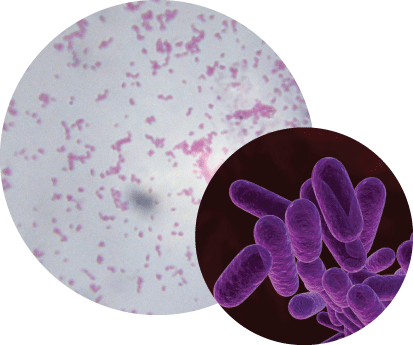 Let's take a minute to review some of the various types of microorganisms. Bacteria are one-celled microorganisms. There are both pathogenic (disease-causing) and nonpathogenic (non-disease-producing) bacteria. In fact, our bodies need certain types of bacteria to help process foods. However, this article will not focus on "good guy" bacteria. We are concerned here about disease-producing, pathogenic bacteria. There are basically three types of bacteria:
Let's take a minute to review some of the various types of microorganisms. Bacteria are one-celled microorganisms. There are both pathogenic (disease-causing) and nonpathogenic (non-disease-producing) bacteria. In fact, our bodies need certain types of bacteria to help process foods. However, this article will not focus on "good guy" bacteria. We are concerned here about disease-producing, pathogenic bacteria. There are basically three types of bacteria:
- Bacilli are rod-shaped bacteria that cause a variety of diseases. Among these diseases are tuberculosis and tetanus.
- Cocci are round bacteria that often occur in groups. There are three types of cocci. Staphylococci grow in small groups. Pustules are an example of an infection caused by staphylococci. Staphylococci can produce various systemic infections, which are those that affect the entire body. Localized infections are confined to one area. A pustule is an example of a localized infection. If an infection spreads into the bloodstream, then it is said to be systemic. Staphylococci infections are sometimes called staph ("staff") infections Streptococci infections cause strep throat. They are another form of cocci. Dipococci, still another form of cocci, pneumonia.
- Spirilla are a third form of bacteria. Spirilla are also called spirochetes. They are spiral in shape. Syphilis is probably the best known disease cause by spirilla.
Bacteria can be active or inactive. In their inactive stage, they form cocoon-like shells called spores. Spores are much harder to kill than active bacteria. This is important to know when we discuss sterilization later in this article.
Viruses are another form of microorganism. Viruses are not really cells, in that they do not have membranes. They are more like pieces of DNA proteins and are very small.
There are various types of fungi. Mold and mildew are examples of fungi. Fungal infections in humans are known as mycoses. Many, many illnesses are caused by microorganisms. The variety of bacteria, viruses, and fungi, and the various diseases they can cause, is much too extensive to discuss in this article. We touch on the basics in order to understand the importance of hygiene and sterilization.
STERILIZATION
Sterilization is the process of killing all microorganisms, including good and bad ones. Sterilization also kills spores – bacteria that are in their inactive stage. True sterilization is performed by a process called autoclaving. An autoclave is a machine that sterilizes equipment, utensils, and other materials through a combination of steam heat and pressure. It works similarly to a pressure cooker. Microorganisms cannot survive in an autoclave.
Autoclaves have a large metal chamber in which can be placed metal surgical instruments, sponges, gauze, and other materials. After the chamber is filled with the materials to be sterilized, a heavy-duty door is shut, locking and forming an air-tight seal.
The autoclave then heats up, at the same time building pressure inside of the chamber. The temperature of the heat goes above the boiling point of 212ºF. Articles are sterile when they have been exposed to very high heat (usually about 260º) and sufficient pressure has built up inside the autoclave. Once the autoclave has reached a sufficient temperature and pressure, materials are left to sterilize for about 20 minutes. The autoclave is then vented, allowing the pressure and temperature to drop. The pressure is so high that it is impossible to open an autoclave during the sterilization cycle.
Items placed in the autoclave are placed in sealed special plastic or paper envelopes so they remain sterile once the
autoclave has completed sterilizing. It is important to read the manufacturer's instructions well before operating an autoclave, because different manufacturers will have different instructions for sterilization procedures.
Some materials cannot be autoclaved. Glass, for example, cannot withstand the high pressure. Check manufacturer's instructions to see what items cannot be autoclaved.
An autoclave is a very important tool for the esthetician as well as any other personal care or health care professional. In this age of AIDS, it is very important to protect your clients and yourself from exposure to any pathogenic microorganisms. The AIDS epidemic brought great attention to sterilization procedures. However, the AIDS virus is relatively easy to kill through sterilization. Hepatitis viruses, tuberculosis bacteria, and other microorganisms actually pose a much greater health risk in terms of sterilization procedures.
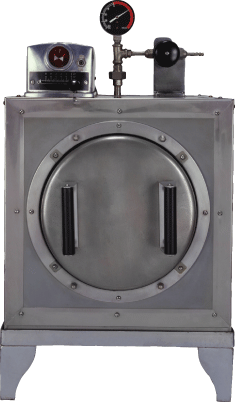 Disinfection is the process of killing the majority of pathogenic microorganisms. Disinfection is the general procedure that is usually followed in the cosmetology industry. Because we do not perform invasive procedures, or procedures that enter the body, we do not have to concern ourselves with the types of sterilization that are used in hospitals. However, we do perform procedures such as extraction, waxing, and tweezing that sometimes expose blood on the surface of the skin. Because of this exposure to blood, we must be very careful to use excellent hygiene and sterile or disinfected materials.
Disinfection is the process of killing the majority of pathogenic microorganisms. Disinfection is the general procedure that is usually followed in the cosmetology industry. Because we do not perform invasive procedures, or procedures that enter the body, we do not have to concern ourselves with the types of sterilization that are used in hospitals. However, we do perform procedures such as extraction, waxing, and tweezing that sometimes expose blood on the surface of the skin. Because of this exposure to blood, we must be very careful to use excellent hygiene and sterile or disinfected materials.
Disinfectants are chemicals that kill pathogenic microorganisms. The most popular disinfectant chemical used in the cosmetology industry is quaternary ammonia. Seventy percent isopropyl alcohol is another commonly used disinfectant for surface disinfecting.
Disinfectants are also used in maintenance, such as disinfectant floor detergents and aerosol sprays, to kill bacteria in the air and control the odor they cause.
Antiseptics are a weaker form of disinfectant. They are usually mild enough to use on the skin. Hydrogen peroxide and other first-aid chemicals are examples of antiseptics.
Aseptic procedure is the term scientists use to describe proper handling techniques of sterilized and disinfected equipment. Placing a sterile comedone extractor on a dirty towel is a violation of aseptic procedure. Handling sterile equipment with other sterile materials is good aseptic procedure.
Theoretically, nothing is completely sterile once a seal has been broken on an envelope of an autoclaved utensil. Because bacteria, viruses, and other microorganisms are in the air, they land on the sterile equipment. But we cannot sterilize a building or a room, so we must do the next best thing in handling disinfected and sterile equipment with the best hygienic techniques possible.
Some hospital disinfectants are somewhat stronger than quaternary ammonia and are being used more frequently in salons, particularly in esthetics and electrolysis practices.
Popular stronger disinfectants are glutaraldehyde, formaldehyde solutions, benzalkonium chloride, and sodium hypochlorite (household bleach). These types of disinfectants are very strong. If they are not thoroughly removed by lots of rinsing, the residue can cause allergic and irritating reactions to the skin.
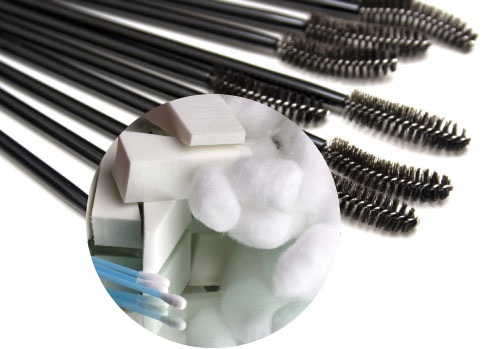
Glutaraldehyde solutions are excellent for disinfecting mask brushes, metal instruments such as tweezers, and other implements that cannot be autoclaved. Glutaraldehyde is available from medical and esthetic supply houses under a variety of
trade names.
Glutaraldehyde often comes in concentrated form. It is mixed with water to form a solution that is potent in killing many microorganisms for three weeks. Read the label well and follow all manufacturer's instructions. Household bleach can be diluted 1:10 with water and serves as a good disinfectant for many articles. Besides being used for laundry, bleach can also be used to disinfect sponges and other linens. Do not use bleach to disinfect metal instruments. Chlorine is extremely corrosive to metals!
DISPOSABLE MATERIALS
The best way to ensure aseptic procedure is to use disposable materials. These materials should be used once and discarded. There is no way to transfer microorganisms from one client to another if you are using disposable materials. Popular disposable items include the following:
- cleaning pads made of sheet (roll) cotton
- disposable one-use lip brushes
- one-use mascara wands
- disposable eyeshadow sponges
- inexpensive cellulose sponges
- cotton swabs
- facial tissue
- wax strips
- disposable spatulas for wax or junior size
- tongue depressors
- paper towels and sheets

Disposables should be discarded in sealed plastic bags. Sharp items such as lancets and electrolysis needles should be disposed of in a "sharps box." A sharps box is a plastic box with a hole in the top in which you place used lancets and needles. The plastic box helps to prevent you or any other persons handling the refuse from accidentally injuring themselves with used lancets or needles. Even though blood is a rarity, it is best to protect everyone by using these precautions.
NONDISPOSABLE ITEMS
Some items must be used more than once. Because of expense and practicality, items such as brush attachments, high-frequency electrodes, mask brushes, suction apparatuses, comedone extractors, and other items must be either sterilized or disinfected.
When cleaning utensils you must be careful not to cross-contaminate the utensils. Cross-contamination means that utensils are accidentally re-exposed to microorganisms during handling. Examples of cross-contamination are rinsing utensils in a non-disinfected bowl, handling clean brushes with dirty towels, and re-dipping used spatulas into the same jar of cream. You must use extreme care not to ever contaminate any item used in treatment by touching it with something that is dirty or has been used on a client.
PROTECTING YOU AND YOUR CLIENTS FROM DISEASE
Besides the many sanitation, disinfection, and sterilization procedures already discussed, it is important that you personally carry out personal sanitation procedures on a routine basis. You must be careful not to reuse disposable items or to contaminate your products by using a spatula more than once. To avoid cross-contamination while removing creams from jars, there are several good techniquesto use:
- Always remove creams from jars with a disinfected spatula. Use spatulas only once before discarding or disinfecting.
- When removing creams from a jar, remove enough for the entire service. It is better to remove too much product than to have to re-dip into the jar. If you need more cream, use a fresh spatula. Place used spatulas in a soaking bowl for later cleaning and disinfecting. You should have at least six spatulas for each client you see per day.
- It is a good idea to use small, disposable paper cups for dispensing creams. You may prepare measured portions of various products early in the day before clients arrive. Because you have measured the correct amount, this procedure eliminates all chances of contamination because you never touch a client's skin during preparation. Store cream portions wrapped in plastic wrap, or use small portion cups with plastic lids, like the kind used in restaurants for ketchup or sauces.
- Pumps are another great idea, because they prevent contamination. Cleansers, fluids, and moisturizers can easily be dispensed from pumps. Squeeze bottles with flip-tops are another good type of dispenser. Using these types of dispensers also saves time in treatment room.
- Tubes or pumps are by far the most sanitary method for retail client use products. Your clients should also be instructed to use spatulas for jars at home. Using tubes or pumps eliminates this problem.
- Wax should also be dispensed using one spatula per dip. Again, a larger amount of wax may be removed and placed in a paper cup for application.
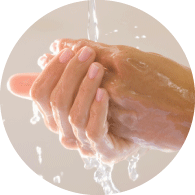 Use of Antiseptic Washes
Use of Antiseptic Washes
Always wash your hands between clients with a good antiseptic soap or wash. Dispensers are the most sanitary method of accomplishing this. Bar soap is not appropriate because you touch and retouch the bar each time you wash your hands.
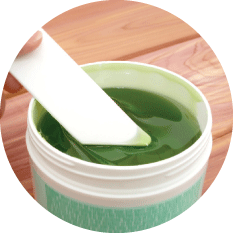 Avoiding Cross-Contamination
Avoiding Cross-Contamination
Contamination means that a surface or substance has been exposed to microorganisms. Cross-contamination occurs when you touch a contaminated surface or substance and then touch a noncontaminated item. For example, if you touch the client's skin with your fingers and then get makeup out of a bottle by dumping it on your forefinger, you have cross-contaminated the makeup in the bottle. If you went to a party and someone took a potato chip, dipped it in dip, ate part of it, and then re-dipped it, that person cross-contaminated the dip. Don't be a "double-dipper"!
The solution would be to use a sanitized or disposable spatula to remove the makeup from the bottle and then place the makeup in a disposable plastic cup. You can re-dip into the disposable cup because it is going to be thrown away.
Another common source of cross-contamination in the salon is the use of bowls that have not been disinfected properly between clients. If you have a bowl of clean water and dip your hands in after you touched the client, the bowl has been contaminated. You must disinfect all bowls between clients using a hospital-grade disinfectant, or you should autoclave the bowls. The best solution is to have a lot of wet sponges, so that you never have to rinse sponges, and use the same rinsed sponge on the same client. Also, never rinse sponges by placing them in a sink. Sinks are loaded with bacteria!
Techniques for Avoiding Blood Exposure During Treatment
Always begin extractions from the chin and work upward on the face. If you should encounter blood, gravity will pull the blood down the face and away from areas you will be extracting from next. While wearing gloves, try to avoid touching anything but the client's skin. Prepackaged, portioned products discussed earlier will help to prevent you from touching any bottle, jars, or other utensils while extracting.
Using a magnifying lamp during extraction helps protect your eyes from exposure to debris. Although mask and eye goggles are necessary for many health care workers, they are not necessary for estheticians. If you work with an assistant, the person should also wear gloves. Blood may accumulate under a mask in an acne treatment, for example. Wear gloves when removing masks or finishing the treatment. It is generally not necessary to wear gloves during makeup application unless you are working with a patient with acne or performing paramedical makeup on a client with open abrasions or incisions. Makeup brushes should also be washed and disinfected between uses. Makeup brushes are damaged much more easily during disinfection than are mask brushes. Be careful to use a mild disinfectant for makeup brushes.
When applying gloves, carefully slip your hand into the glove then check the glove for any small tears or holes. Gloves with holes should be immediately discarded. To remove soiled gloves, grab a section of the cuff (the wrist part of the glove) and remove the glove, turning the glove inside out. Repeat with the other glove. Turning gloves inside out will prevent accidental contact with the soiled part of the glove. Discard used gloves immediately.
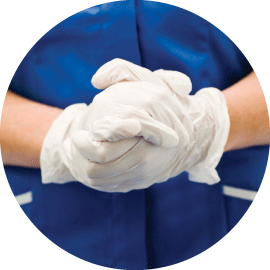 IN CONCLUSION
IN CONCLUSION
The esthetician is at relatively little risk of infection with most microorganisms. However, it is important to take precautions to always avoid contact with blood or other bodily fluids. Always wear gloves and use the disinfection and sterilization procedures outlined within this article. Laws vary slightly from state to state. Make sure you are thoroughly acquainted with your state sanitation rules and laws regarding the practice of esthetics. Most important, use common sense. Always be aware of your professional hygiene techniques. Constantly practicing good techniques will become a habit.
 Mark Lees, Ph.D., M.S. is an award-winning speaker and product developer, and has been actively practicing clinical skin care for over 20 years at his CIDESCO accredited Florida facility, which has won multiple consumer awards. His professional line of clinical products, specializing in acne, sensitive, and aging skin, is available throughout the United States at licensed skin care facilities. His professional awards are numerous and include American Salon Magazine Esthetician of the Year, the Les Nouvelles Esthetiques Crystal Award, and the Dermascope Legends Award. Dr. Lees has also been inducted into the National Cosmetology Association's Hall of Renown. Dr. Lees is author of the popular book, Skin Care: Beyond the Basics, now in its 3rd edition.
Mark Lees, Ph.D., M.S. is an award-winning speaker and product developer, and has been actively practicing clinical skin care for over 20 years at his CIDESCO accredited Florida facility, which has won multiple consumer awards. His professional line of clinical products, specializing in acne, sensitive, and aging skin, is available throughout the United States at licensed skin care facilities. His professional awards are numerous and include American Salon Magazine Esthetician of the Year, the Les Nouvelles Esthetiques Crystal Award, and the Dermascope Legends Award. Dr. Lees has also been inducted into the National Cosmetology Association's Hall of Renown. Dr. Lees is author of the popular book, Skin Care: Beyond the Basics, now in its 3rd edition.
From LEES. Skin Care, 3E. © 2007 Delmar Learning, a part of Cengage Learning, Inc. All rights reserved. Reproduced by permission. Text/images may not be modified or reproduced in any way without prior written permission of the publisher. www.cengage.com/permissions
Want to read more?
Subscribe to one of our monthly plans to continue reading this article.